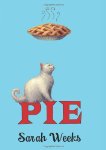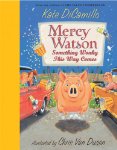 I have a confession to make. I am not really that fond of pies. I don't dislike them, but if I have a choice between pie and cake, I will choose cake. I know that some of you will be appalled when they hear this, but I am being honest.
I have a confession to make. I am not really that fond of pies. I don't dislike them, but if I have a choice between pie and cake, I will choose cake. I know that some of you will be appalled when they hear this, but I am being honest. When I found out about today's book, I was not that keen to read it. How could a book called Pie be interesting? I began to read it, and in about two pages I was hooked. Yes, the book is about pie, but it is also about the people who make pies. It is about doing something that you love, and then sharing that love with others. I loved this book and I don't think I will ever look at a pie the same way. In fact, I may even try some of the recipes that are included in the book.
Sarah Weeks
Fiction
For ages 9 to 12
Scholastic, 2011, 978-0545270113
The town of Ipswitch , Pennsylvania
For Polly, making pies is gift that she loves to share with others. Though she could have made millions by selling her recipes, she has always refused to do this. Instead, she opened a pie shop in Ipswitch and she gives away the pies she makes. She sincerely believes that the reason why her pies are special is because they are made with love.
Polly also gives her love to her niece Alice, who loves her aunt Polly with all her heart. Alice
One day, quite suddenly Aunt Polly dies. Alice
Now that Polly is not around to keep winning the Blueberry pie contest, everyone in town goes pie mad. Unfortunately, no one, especially Alice Alice
Alice and her friend Charlie decide that they have to find out who is behind these strange occurrences, and when they finally find out the truth, they discover much more than they ever imagined they would.
This marvelous book not only tells a delightful story, but it also shows readers that the road to happiness is not paved with fame and fortune. Instead it is paved with love and kindness and you are blessed if you are able to spend your days doing something that you love.
This story is written with warmth, humor, and sensitivity, and the descriptions of Aunt Polly’s pies are almost more than a normal person can bear. Luckily, the author includes fourteen pie recipes that will surely delight readers who fancy tasting Aunt Polly’s creations for themselves.




















